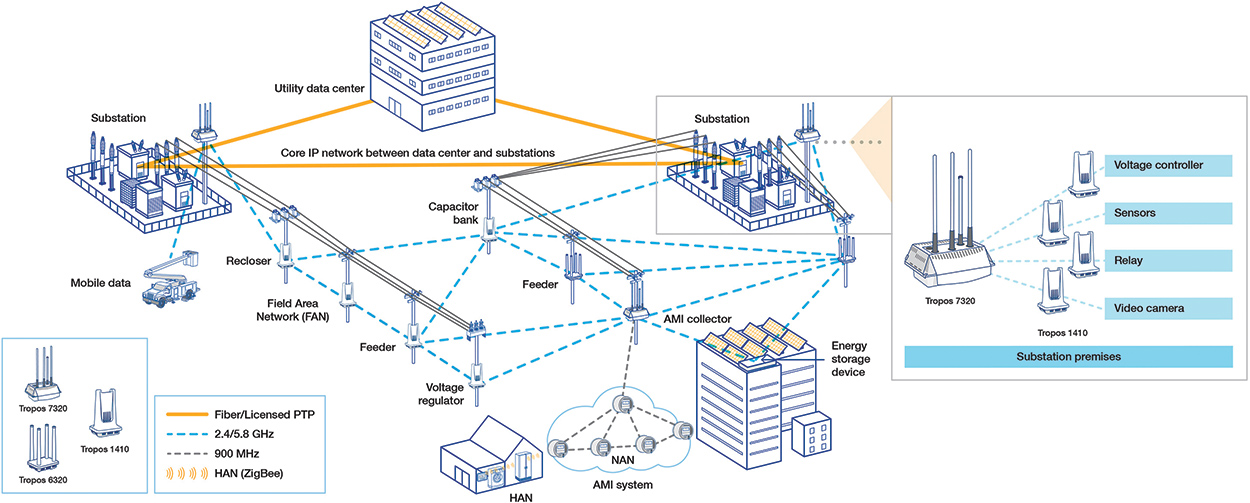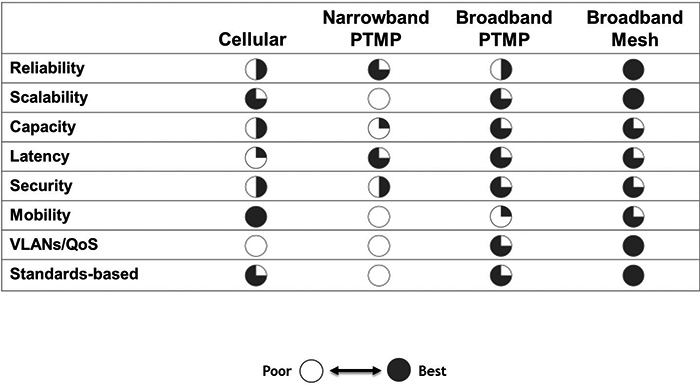Increasingly, utilities are deploying intelligent electronic devices (IEDs) and other smart apparatus in substations and along distribution feeders as well as equipping field workers with laptop, tablet and handheld computers. These technologies are often labeled smart grid. They enable valuable applications such as automated metering infrastructure (AMI), substation automation, distribution automation, outage management, automatic load shedding, and the ability to manage alternative energy sources.
Two way smart grid communication links the people and devices in the field with software at substations and the utility’s operations center, enabling applications that deliver vast improvements in efficiency, security, reliability and resiliency. Extending communication from the substation control house to the substation yard and along distribution feeders is best accomplished using wireless field area communication networks. This article discusses the requirement for a utility wireless field area network and describes how a wireless mesh network architecture can meet these requirements.
Typical Utility Communication Network Architecture
Utilities typically implement a multi-tier communication network architecture described as follows and illustrated in Figure 1, below:

Figure 1: Typical Utility Communication Network Architecture
(click to enlarge)
- Tier 1: The utility’s core IP network, shown in yellow in Figure 1. It is generally implemented using fiber and point-to-point (PTP) wireless. In the example of a utility, the core IP network often connects many of the distribution substations. The demarcation point between the Tier 1 network and Tier 2 network is generally a port on a VLAN-capable Ethernet switch. The Tier 1 network connects to the Tier 2 Field Area Network (FAN).
- Tier 2: The FAN, shown by the dashed blue lines in Figure 1. This tier uses wireless technology, usually broadband wireless mesh, point-to-multipoint (PTMP), and/or cellular data. Substation automation devices (e.g., breaker controllers, voltage regulators, and remote terminal units (RTUs)), distribution automation devices (e.g., capacitor bank controllers, recloser controllers, and smart transformers), AMI collectors, and mobile workers equipped with laptops, tablets or handhelds connect to the FAN. FAN connections can be wireless or wired Ethernet or serial links.
- Tier 3: The Neighborhood Area Network (NAN) or advanced metering infrastructure (AMI) network, including smart meters and collectors. This tier is illustrated by the dashed grey lines in Figure 1. It is generally implemented using narrowband wireless mesh or cellular data. When a broadband wireless mesh network is used to implement the Tier 2 network, the AMI collectors in the Tier 3 networks are generally co-located with the mesh routers that form the Tier 2 network. The collectors attach to a wired Ethernet port on the mesh routers.
- Tier 4: The Home Area Network (HAN). HANs are implemented using ZigBee or HomePlug technology. They network smart appliances and in-home displays, connecting to the NAN via a smart meter. The HAN is shown inside the house in the lower middle portion of Figure 1.
Note: The remainder of this article focuses on the Tier 2 FAN.
Field Area Network Requirements
FANs fill the communication gap between the core Tier 1 networks and devices, as well as personnel, in the field. FANs are most often implemented with wireless networking technologies because their large geographic coverage areas, large number of connected devices and the need to support mobile field workers make it technically and economically infeasible to implement them using wired technologies. Wireless networking technologies used in FANs include cellular, narrowband point-to-multipoint (PTMP), broadband PTMP and broadband wireless mesh networks.
To support many applications concurrently, FANs must meet the superset requirements of all current and future smart grid applications.
High Reliability
Communications are most critical during outages. FANs must operate even when events disable the electric grid. Ideally, the wireless network will incorporate cognitive radio software that can, for instance, automatically route around interference, failures and congestion. Individual communication devices must be ruggedized, weatherized, and supply battery backup.
Scalable
Field area communication networks must scale to cover large geographic areas, potentially the utility’s entire service territory. They must also scale to support, directly or via NANs, millions of connected devices. At the same time, because utilities may choose to roll out their smart grids incrementally, the FAN must be economical to implement on a small scale, say at a single substation or along a single distribution feeder.
High Performance
Traditionally, utility applications sent and received little data. Consequently, utilities generally installed low capacity networks.
As IEDs and other intelligent field devices proliferate, become smarter and gather more information, capacity needs are changing. High capacity networks are required because more applications and devices use the FAN and they send and receive more data. Additional capacity is also required to support mobile workforce applications.
Many applications in the distribution system are not latency sensitive. However, the few that are, including protection and safety applications, are critical. Because a unified FAN must support the requirements of all deployed applications, low latency is essential.
Because of these factors, utility FANs must deliver sufficient capacity to support all current and future smart grid applications simultaneously and provide latency that is low enough to support the most delay sensitive application.
Secure
Like all networks, wireless field area networks come with potential vulnerability to cyber-attacks. In IP-based FANs, this challenge can be met by implementing a multi-layer, defense-in-depth security architecture using enterprise tools and techniques.
Mobility
Providing communications for field crews requires that the FAN support mobility.
Multi-Application
It may seem a tautology that a network that can support many applications must offer multi-application support. However, supporting multiple applications on a network drives some specific technical requirements such as the need to provide virtual local area networks (VLANs) and and quality of service (QoS). For example, while low latency is essential, it doesn’t help if traffic for safety and protection applications is stuck in a queue behind less important traffic, e.g., AMI interval reads. Therefore, application prioritization is required to ensure that delay-sensitive traffic gets to its destination in time.
Flexible
To support the widest variety of applications and devices, the FAN must be built on industry standards such as TCP/UDP/IP, 802.11 (Wi-Fi) and 802.3 (Ethernet). To best integrate legacy field devices and avoid stranded assets, the FAN must also support secure network connections to devices that use serial links and automation protocols.
Field Area Communication Network Technology Choices
As shown in Figure 2, numerous wireless technology choices exist for implementing FANs. However, when the characteristics of these technologies are compared to FAN requirements, broadband wireless mesh networks, supplemented by PTMP links when needed, best meet the requirements.

Figure 2: Wireless FAN Technology Choices
Broadband wireless mesh networks offer the following characteristics:
Highly available: Wireless mesh networks provide high availability by automatically selecting the best route through the network from multiple radio frequency (RF) paths, channels and bands. To withstand extremes in climate, mesh routers with extended operating temperature ranges, enhanced wind survivability and housings fabricated using specialized alloys and plating are available.
Scalable: Broadband wireless mesh networks have been proven to scale to large coverage areas (3,000 square miles in Abu Dhabi), large number of users transferring massive volumes of data (19,000 users transferring nearly 600 GB of data daily in Google’s Mountain View, California network, 1 TB of data transferred daily in Ponca City, Oklahoma), large numbers of M2M end-points (more than 1 million electricity and water meters in Abu Dhabi) and large numbers of routers (more than 3,000 routers operating in the network in Abu Dhabi). However, because mesh networks generally don’t require tower construction, they can also economically cover small areas, such as a single distribution feeder.
High capacity and low latency: Broadband wireless mesh networks can provide >10 Mbps of throughput at each mesh router with latency of <1 ms per mesh hop.
Secure: Broadband wireless mesh networks can implement a multi-layer, defense-in-depth security architecture using open security standards. Open standard, enterprise security tools and techniques have been honed for years and are constantly being updated. As a result, utilities can leverage the past and ongoing work of the enterprise and internet security community. Using a multi-layer, defense-in-depth approach with standards based tools wireless mesh networks have attained FIPS 140-2 compliance and are compatible with NERC CIP v5, NISTIR 7628 and IEC 6235.
Mobility: Broadband wireless mesh networks provide seamless, session-persistent roaming at vehicular speeds for as long as they stay within the mesh coverage area. Clients, including those that have established an IPsec/VPN connection, can move between nodes, gateway and even IP subnets without losing connections. The best mobile network connections can be achieved by using a mobile mesh router.
VLANs/Application QoS: Broadband wireless mesh networks support VLANs and QoS. VLANs enable traffic from different applications and user groups to be segregated. They permit security and QoS policies to be tailored to the needs of each application/user group. QoS capability ensures that traffic for latency-sensitive mission-critical applications are prioritized relative to latency-insensitive communications such as metering data.
Flexibilty/Interoperability/Open Standards: Broadband wireless mesh networks support open standards so that they can interoperate with other standards-based smart grid components. Standards supported by wireless mesh networks include TCP/UDP/IP, 802.11 (Wi-Fi) and 802.3 (Ethernet). To integrate legacy field devices and avoid stranded assets, some mesh routers also support secure network connections to devices that use serial RS-232 or RS-485 links and automation protocols such as DNP-3 and IEC 61850.
Implementing Field Area Communication Networks Using Broadband Wireless Mesh
Broadband wireless mesh networks are implemented by installing mesh routers throughout the coverage area. Along a feeder, units typically mount on the horizontal mast arm of a street light pole or to a power pole and are typically AC powered. To provide wireless communication across a substation floor, mesh routers can be mounted to structures and equipment within the substation. Mobile mesh routers can be installed in vehicles.
Some mesh routers, called gateways, connect to the Tier 1 core IP network. In areas where gateways are required but a fiber drop to the Tier 1 network is not readily available, PTMP wireless links can fill the void. The percentage of mesh routers configured as gateways varies depending on the amount to traffic that needs to travel to/from the Tier 1 network and the FAN.
Mesh routers not configured as gateways communicate entirely via wireless. Upon installation, mesh routers automatically discover one another and self-organize into an interconnected wireless mesh network. Each mesh router determines the presence of both clients and other mesh routers. Once a mesh router has identified the existence of other like devices, it builds a table of neighboring devices and the corresponding paths through the network that each neighbor provides. The mesh router then identifies the optimal path to send data across the network, to the wired gateway.
Not All Mesh Networks Are Created Equal
Unfortunately, in the utility industry, the term mesh network has created some confusion because two different types of mesh networks are used for two different applications.
Utilities tend to be more familiar with the AMI meter meshes used to implement the NANs that transport metering data between meters and their associated AMI collectors. These narrowband mesh networks use lower frequency bands, supply much less capacity and cover smaller geographic areas with fewer connected devices than the broadband mesh networks that are the subject of this article.
Broadband wireless mesh networks use higher frequencies, typically the 2.4 GHz and 5 GHz RF bands. These frequency bands supply more and wider RF channels, providing higher capacity and the option to automatically move between channels within a band and between bands to mitigate interference. Broadband mesh networks have been proven to scale to very high capacity (1 TB per day), large coverage areas (3,000 square miles) and large numbers of connected devices (1 million).
Conclusion
Communication networks are a key component to smart grid implementation. Utilities implementing smart grid communication networks generally use a multi-tier network architecture. A number of wireless technology choices are available to Tier 2 network – the field area network or FAN. When comparing the capabilities of these technology choices to the requirements of the FAN, broadband wireless mesh networks, supplemented by PTMP links when necessary, provide the best match to the requirements.
About the Author
 Bert Williams is the Director, Global Marketing for ABB Tropos Wireless Communication Systems and brings 30 years of experience in successfully leading the marketing organizations of networking companies. Mr. Williams was Vice President of Marketing for Tropos Networks from 2002 to 2007 and returned to the company shortly before its acquisition by ABB after working as an executive marketing consultant for four years. Prior to Tropos, Bert held senior marketing positions at Alteon WebSystems (acquired by Nortel Networks), Qualix Group, SynOptics Communications (part of Bay Networks), Synernetics and Advanced Micro Devices. He holds a BS with University Honors in Electrical Engineering from Carnegie Mellon and an MBA from Harvard Business School.
Bert Williams is the Director, Global Marketing for ABB Tropos Wireless Communication Systems and brings 30 years of experience in successfully leading the marketing organizations of networking companies. Mr. Williams was Vice President of Marketing for Tropos Networks from 2002 to 2007 and returned to the company shortly before its acquisition by ABB after working as an executive marketing consultant for four years. Prior to Tropos, Bert held senior marketing positions at Alteon WebSystems (acquired by Nortel Networks), Qualix Group, SynOptics Communications (part of Bay Networks), Synernetics and Advanced Micro Devices. He holds a BS with University Honors in Electrical Engineering from Carnegie Mellon and an MBA from Harvard Business School.








